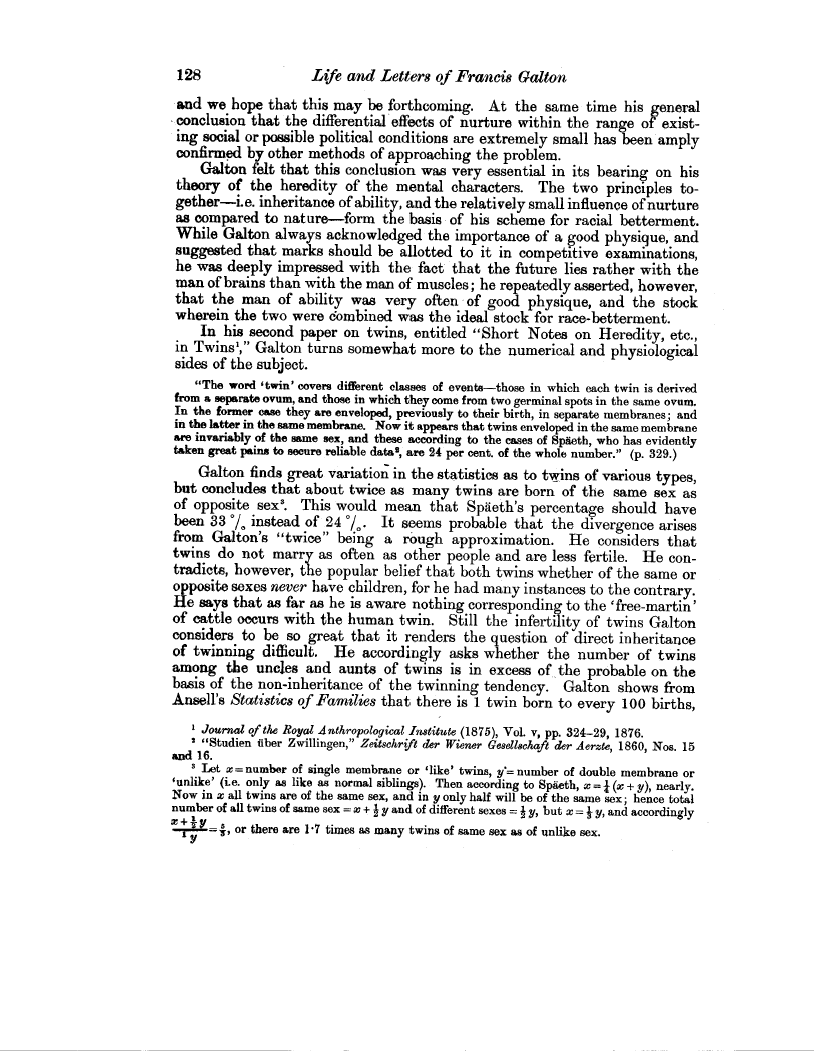128 Life and Letters of Francis Galton
and we hope that this may be forthcoming. At the same time his general conclusion that the differential effects of nurture within the ran of existing social or possible political conditions are extremely small hasten amply confirmed by other methods of approaching the problem.
Galton felt that this conclusion was very essential in its bearing on his theory of the heredity of the mental characters. The two principles together-i.e. inheritance of ability, and the relatively small influence of nurture as compared to nature-form the basis of his scheme for racial betterment. While Galton always acknowledged the importance of a good physique, and suggested that marks should be allotted to it in competitive examinations, he was deeply impressed with the fact that the future lies rather with the man of brains than with the man of muscles; he repeatedly asserted, however, that the man of ability was very often of good physique, and the stock wherein the two were combined was the ideal stock for race-betterment.
In his second paper on twins, entitled "Short Notes on Heredity, etc., in Twins'," Galton turns somewhat more to the numerical and physiological sides of the subject.
"The word 'twin' covers different classes of events-those in which each twin is derived from a separate ovum, and those in which they come from two germinal spots in the same ovum. In the former case they are enveloped, previously to their birth, in separate membranes; and
in the latter in the same membrane. Now it appears that twins enveloped in the same membrane are invariably of the same sex, and these according to the cases of Spaeth, who has evidently taken great pains to secure reliable data$, are 24 per cent. of the whole number." (p. 329.)
Galton finds great variation in the statistics as to twins of various types, but concludes that about twice as many twins are born of the same sex as of opposite sex'. This would mean that Spaeth's percentage should have been 33 °/o instead of 24 °/o. It seems probable that the divergence arises from Galton's "twice" being a rough approximation. He considers that twins do not marry as often as other people and are less fertile. He contradicts, however, the popular belief that both twins whether of the same or opposite sexes never have children, for he bad many instances to the contrary. He says that as far as he is aware nothing corresponding to the 'free-martin' of cattle occurs with the human twin. Still the infertility of twins Galton considers to be so great that it renders the question of direct inheritance of twinning difficult. He accordingly asks whether the number of twins among the uncles and aunts of twins is in excess of _the probable on the basis of the non-inheritance of the twinning tendency. Galton shows from Ansell's Statistics of Families that there is 1 twin born to every 100 births,
1 Journal of the Royal Anthropological Institute (1875), Vol. v, pp. 324-29, 1876.
x "Studien caber Zwillingen," Zeitschrift der Wiener Gesellschaft der Aerzte, 1860, Nos. 15 and 16.
' Let x = number of single membrane or 'like' twins, y= number of double membrane or 'unlike' (i.e. only as like as normal siblings). Then according to Spaeth, x=I (x + y), nearly. Now in x all twins are of the same sex, and in y only half will be of the same sex; hence total number of all twins of same sex = x + I y and of different sexes =1y y, but x = - y, and accordingly
x + y - , or there are 1.7 times as many twins of same sex as of unlike sex.
y

